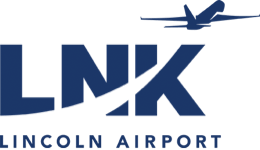Lincoln and the History of Aviation
Lincoln Airport Authority
“Lincoln…An Important Aircraft Production and Airport Center”
Proclaimed by the city’s chamber of commerce in 1929, these words symbolize the key position Lincoln, Nebraska, has occupied in the history of aviation.
- Production to Pageantry
- Engineering to Experimenting
- Wing-Walking to Barnstorming
- Nuclear Deterrence to Commercial Flight
Lincoln, Nebraska has played in helping humans dream among the clouds.
By the turn of the 20th century, Nebraskans were increasingly "air-minded." Above, a drawing fashioning an ear of corn as a dirigible (an early type of lighter-than-air aircraft similar to a blimp).
Early Flight in Lincoln
Experimentation in flying came from all directions in Nebraska during the 1890s and early 1900s
The Baysdorfer brothers of Omaha, prolific innovators in their own right:
- Created the Comet: a lighter-than-air airship considered to the be the first Nebraska-built one of its kind.
- Constructed the first Nebraska-built airplane in Omaha in 1910.
Charles E. Taylor bust at the National Museum of the U.S. Air Force.

Charles E. Taylor: "The First Aviation Mechanic"
- Charles Taylor, a former Lincoln resident, assisted the Wright Brothers in their design and construction of the engine that powered the Brothers’ first flight.
- Taylor was introduced to the Wright Brothers when he and his young family moved to Dayton, OH, in 1896.
- Taylor designed and built the engine that powered the Wright Brothers’ famous flight at Kitty Hawk in 1903.
- Taylor later helped power the first transcontinental flight of Cal Rodgers in 1911.
Charles E. Taylor bust at the National Museum of the U.S. Air Force.

Early Aircraft Manufacturing and Schooling
- Harding, Zook, and Bahl (1919-1921)
- Lincoln Airplane and Flying School (1929-1945)
- Lincoln Standard Aircraft Co., Inc. (1922-1931)
- Union Airport (1930-1964)
Lincoln Airplane and Flying School students.
Perhaps the first photo taken of Charles Lindbergh while learning to fly in Lincoln (suggested to be the individual in the postboy hat helping lift the plane).
Brochure from the Lincoln Airplanes and Flying School, History Nebraska (RG1475).
An image collage in “Aviation Beckons You” persuading prospective flyers to train at Lincoln Airplane and Flying School.
Certificate issued by the United States Department of Commerce licensing the Lincoln Airplane and Flying School.
Facilities of Lincoln Airplane and Flying School associated with Union Airport near Havelock, History Nebraska.
The Daily Nebraskan, 03 February 1920, Bahl, a former lieutenant in the army, designed and produced the "Lark" monoplane, a new type of affordable aircraft that the company advertised as "the plane for the average man."
Single-engine, two-seat biplane aircraft built by the Nebraska Aircraft Corporation in Lincoln, later known as the Lincoln Standard Aircraft Company; Courtesy of the National Air and Space Museum.
Series of plans included in Lincoln Standard Aircraft Company promotional material relating to the iconic Lincoln Sport Plane.
Series of plans included in Lincoln Standard Aircraft Company promotional material relating to the iconic Lincoln Sport Plane.
"Flying School Hanger," (History Nebraska). Union Airport around 1940 when the Lincoln Airplane and Flying School conducted flight lessons there.
"Lincoln Needs Airport” LJS, O4 Apr 1928
Lincoln Journal Star, Wednesday, 25 July 1928. Map outlining new site for Lincoln Municipal Airport as it appeared in the Lincoln Journal Star on approval day.

July 1928
- A 160-acre plot of land NW of the PO chosen after weeks of intense debate
- ≥ 5 other sites around Lincoln considered
- Flader Tract chosen because cost (price per acre), naturally flat (little development required), guarantee of well-lit and safe airfield for airmail, and pressure from Department of Commerce: Aeronautics Division
The Lincoln Star, 26 Aug. 1928
Nebraska State Journal, 27 January 1929, p.12. A diagram of the future Lincoln Municipal Airport that appeared in the same article that detailed the tragedy that prompted the movement to construct a better-equipped flying facility.

Lincoln Municipal Airport is completed, dedicated
- Surveying, seeding, construction, inspections
- Opened in 1929
- Omaha-Lincoln-Wichita air route
- Dedication in June 1930
Aerial view of Lincoln Municipal Airport, 1939
"Airport, Lincoln, Nebraska" (History Nebraska). The first terminal building of Lincoln Municipal Airport around February 1941.
World War II-era communications safety poster created and posted by the Public Relations Office at Lincoln Army Air Base, c.1943-1945.

Lincoln Army Airfield
- 1942 – Lincoln trained servicemen including mechanics, pilots and flight crews
- Bombardment practice
- De-activated in 1945
- Military-related activity persisted into the late 1940s and early 1950s
Aerial View of Lincoln Air Base, Lincoln, Nebraska (History Nebraska). Aerial view of Huskerville at Lincoln Army Airfield, c.1945.

Huskerville
- Federal Public Housing Authority Project
- Post-WWII housing for veterans (many of whom UN students)
- Private bus route, cafeteria, post office, grocery store, movie theater
- Polio outbreak of 1952
- Torn down around 1966, repossessed to the city and later the LAA
Entrance to Lincoln Army Air Force Base. Photo from "Peace is Our Profession" booklet. (Nebraska State Historical Society)

Lincoln Air Force Base
- Activated by Strategic Air Command, 1952
- Improved runways and aviation infrastructure
- New barracks, mess halls, recreation facilities, warehouses, weapons bunkers
- Commercial aviation continued to operate
- De-activated in mid-1960s as technology surpassed landlocked airbases
Lincoln Air Force Base and the Lincoln skyline from Huskerville

Lincoln, Institutionalization and Aviation
- Airport Authorities Act (1957)
- Federal Aviation Agency/Administration (1958)
- Lincoln Airport Authority (1959)
Lincoln's Proposed New Commercial Airport," Lincoln Journal Star, 23 January 1959. As the map above shows, having the airport next to Lincoln Air Force Base was not guaranteed.
The mid-20th century Lincoln Airport in the foreground, and the construction of the modern Lincoln Airport in the background

Modern Lincoln Airport: Lincoln’s New “Front Door”
- Opened: December 4, 1974
- Dedicated June 6, 1975
- Boasted 42 flights in/out of LNK daily
- Serviced Chicago, St. Louis, Denver, Minneapolis, Kansas City

Into the Future...

